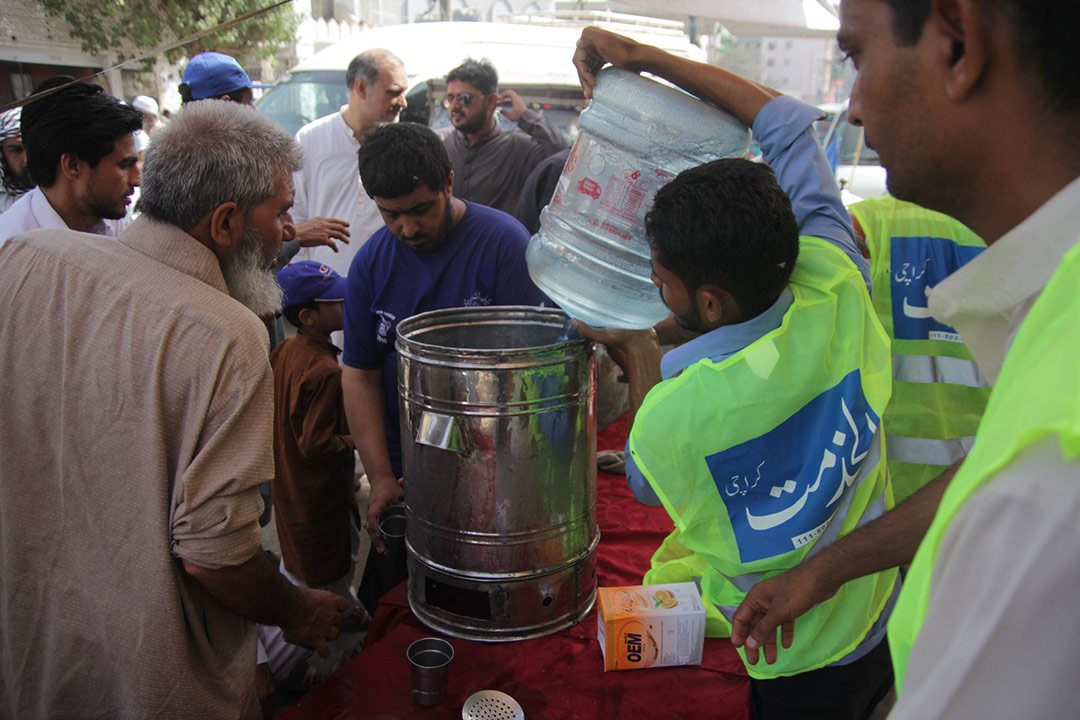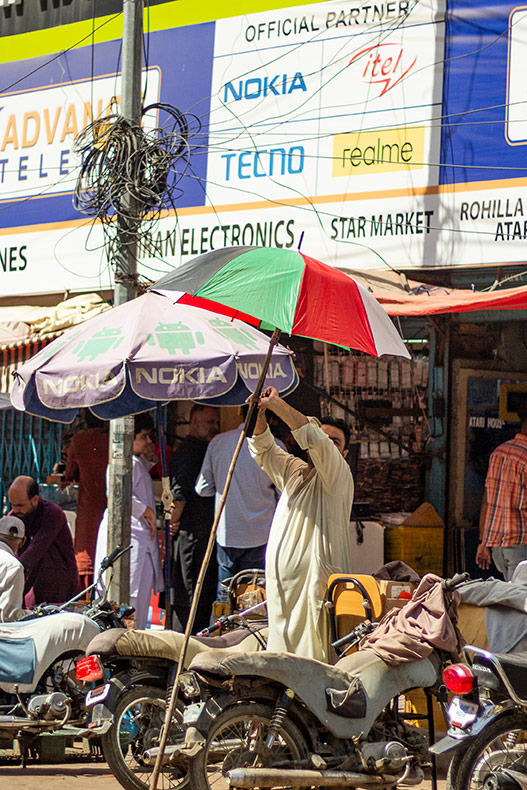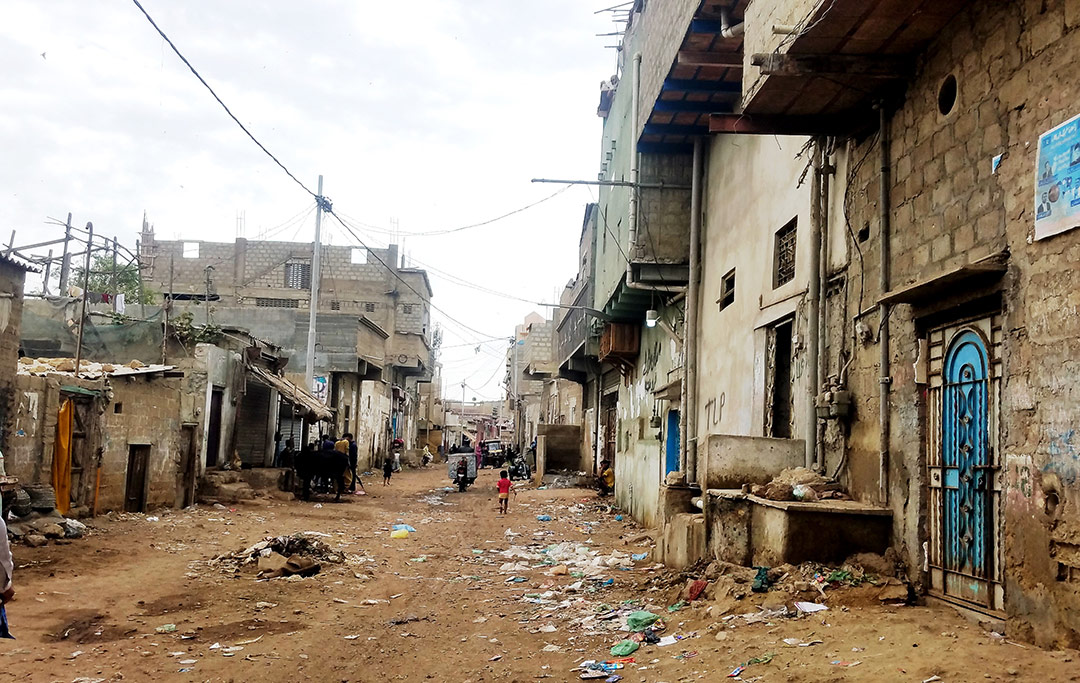Raheem walks around the city with a moistened cloth covering his head for protection against the scorching rays of the sun. The temperature on this May 2022 afternoon is 42 degrees. A heat wave warning has been issued by the Pakistan Meteorological Department (PMD), advising people to avoid going outdoors during peak sunlight hours, and to keep themselves hydrated. However, for Raheem, staying at home is not an option. He works on daily wages: choosing to ‘stay indoors’ on a hot day would mean the family goes hungry at night. Raheem remains on the lookout for heat wave camps near his place of work: “these camps are like oases for me; I can sprinkle my face here, I can get a cool sherbet. May Allah bless the government,” he says. Unbeknownst to him, most of these camps have been set up by the city’s philanthropic organizations and citizen groups; political representatives, municipal bodies, and provincial government functionaries are barely visible on the ground on hot days – perhaps they have been following the PMD’s advisory to ‘stay indoors’ a bit too religiously.

People gather around a heat wave relief camp set up by the philanthropic organization ‘Alkhidmat Karachi’ for a drink of cold water infused with Oral Rehydration Salts, June 2018. Source: Alkhidmat Karachi
In this piece, using Karachi as a proxy for rapidly warming Southern cities, we examine various forms of ‘heat (in)action’ when heat is in action in the city. What do Heat Action Plans imply? How are the logistics and delegation of heat action formulated? And what is heat inaction? Situating these inquiries within anecdotal and empirical vignettes, we dissect the convoluted nature of Karachi’s urban thermopolitics (Staroseilski, 2014) to conceptualize several ‘logics of inaction’ (Sharman and Perkins, 2017; Dobson and Dempsey, 2021) around extreme heat in the city. In the state’s redistribution of the responsibility for managing heat onto a fragmented cacophony of stakeholders as the former’s strategy of ‘governance through inaction’ (Bjarnesen, 2023), we position urban heat and its impacts within the discursive and pragmatic framework of a thermopolitics that is evidently incapacitated and demonstrably farcical when it comes to managing heat.
Karachi’s Thermalscapes
Karachi is located in Pakistan’s southern province of Sindh – a region declared South Asia’s hotspot for climate change (Mani et al., 2018). It is the largest city of Pakistan, with an official population of 16 million[1] (PBS, 2021), and unofficial estimates of 25 million. Temperatures in the city have been increasing at alarming rates: over 60 years, Karachi has witnessed nighttime temperature increases of 2.4ºC, while daytime temperatures have increased by 1.6ºC (Anwar et al. 2022). More recently, Karachi has also experienced several extreme heat events. The 2015 heat wave in the city, considered as the fifth deadliest heat wave recorded in global history, claimed over 1180 lives according to the city authorities – although, anecdotal and observational evidence suggests the toll to be much higher. This event had triggered a host of arbitrary, non-coordinated responses by urban political actors and philanthropic organizations. Eventually, a Heatwave Management Plan (HMP, Commissioner Karachi, 2017) was developed by the Commissioner’s Office. While this document borrowed heavily from neighboring India’s Ahmedabad Heat Action Plan (AHAP, AMC, 2016), it failed to account for certain context-specific attributes of Karachi’s urban heat, such as the suffocatingly high humidity levels specific to the city and remained largely oblivious to the city’s pre-existing thermo-spatial inequalities, which are crucial to understanding the differentiated effects of extreme heat on various kinds of thermally vulnerable urban populations.

People working outdoors in Karachi employ different strategies to fend for themselves on hot days. Source: Karachi Urban Lab
Karachi’s 2015 heat wave had caught the city’s population and its administration unaware, and eventually came to (inaccurately) symbolize the understanding of ‘heat’ for Karachi and indeed Pakistan. However, we situate the politics and governance of extreme heat in the city further back in time than this particular event. We underscore that issues of climatic and thermal justice are inherently codependent on pre-existing issues of socio-spatial urban (in)justice. Karachi is, materially, socially, and cognitively, a city that has developed along moments and spectacles where radical inequality has become embedded in core urban processes: land, economies, domestic space, and cooling infrastructures are all (re)distributed differentially across urban populations. This inequitable spatio-temporal structuration of urban resources complicates normative narratives of urban heat management.
Karachi is marked by a covert albeit violent genealogy of thermal inequities. Over time, erratic waves of migration have resulted in a rapidly expanding yet poorly regulated urban footprint, making various populations disproportionately vulnerable to the impacts of deadly heat indoors and outdoors. Dense informal settlements, covering merely nine percent of the city’s urban land, represent everyday living conditions for about 62% of the city’s population (Anwar et al., 2021).
Against the backdrop of this highly unequal and intense city (Abdullah et al., 2022), urban politics in Karachi has become increasingly fragmented, arbitrary, and parochial. ‘Planning’ for the city remains an elusive domain: instead of being delegated to immediate municipal actors, spatial planning has been re-captured by the provincial government. This has further de-contextualized and abstracted localized decision making, particularly on the morphologies and densities of the built environment – factors which directly compound thermal vulnerabilities for particular kinds of populations. These intersectionalities have critical implications for urban heat management, as well as for orchestrating an urban thermopolitics: not only when it comes to documenting, understanding, and predicting thermal impacts; but also for prescribing realistic and pragmatic heat mitigation (in)actions for the most thermally vulnerable urban subjects.
Conceptualizing heat (in)action
We complicate two kinds of ‘action’ around heat management in the city. The first purported action is the direct, unsolicited, and whimsical delegation of immediate relief provision by the state to non-state actors, such as philanthropic organizations. The second action is shifting the onus for everyday navigation of heat onto individual urban subjects. Both of these, we claim, actually constitute multiscalar forms of inaction in heat governance.
Firstly, while interventions by non-state actors – like setting up heat camps and water coolers in public spaces – do provide immediate thermal relief, such interventions constitute an action framework that is, at the scale of a massive city like Karachi, arbitrary, subjective, and non-coordinated. Such individual evanescent actions are based on fallacious interpretations of ‘heat’ as a discrete and predictable event. Consequently, each organization or private relief provider relies on subjective evaluations of and improvisations in heat mitigation actions based loosely either on broader organizational protocols or individual convictions of ‘kindness’ and ‘virtue’:a religious scholar at a consultative workshop held in April 2021 remarked: “It is written in our religion that if a person is planting date trees and during the process the call to prayer is being recited, one should continue the planting.”

A typical informal settlement in Karachi. Source: Karachi Urban Lab
Non-state entities providing heat relief see this as an act of collective moral and social responsibility, rather than an obligation on the state. But most such relief actions are effervescent, cosmetically deployed, and invoke tactics to be intentionally visible in the public eye, such as exhibiting banners and organizational logos on heat camps sponsored by individuals and private groups. Such actions punctuate the city’s thermotemporal rhythms as individual, momentary spectacles, and dissipate soon after. Even actions that are claimed as having long-term impacts, such as plantation drives, taper off into oblivion as collective memory of the heat event subsides over time. Hence, these delegated actions cannot be upscaled or replicated across the city in a cohesive manner: within the scales of urban space and urban time, they constitute a kind of ameliorated inaction.
The second action involves shifting the onus of managing extreme urban heat from the state downwards onto gendered individual bodies, such as men working outdoors during peak heat hours and women confined within hot-humid domestic spaces. This is achieved by actively circulating flyers and text messages containing heat advisories as well as specific instructions, such as staying indoors and keeping oneself hydrated. But such prescriptions are far removed from the ground, as Raheem’s predicament illustrates. The monthly costs of privately acquired drinking water amongst Karachi’s low-income households range from 200-1250 PKR (0.7-4.5 USD) per capita, where minimum monthly wage is roughly 25000 PKR (90 USD). The city’s fractured hydropolitics is inadvertently tied to the thermopolitics of cooling infrastructures (non)available to particular populations. The state, however, remains oblivious to such intricacies of everyday practice, employing shifting the onus as a strategy to absolve itself of its responsibility towards effective heat action. The cluelessness, resourcelessness, and incapacity of Karachi’s municipal and bureaucratic representatives is aptly captured by the quote below:
There is no defined role of the PDMA (Provincial Disaster Management Authority); everything falls on my shoulders; I am the PDMA and the DDMA (District Disaster Management Authority). Just today, there was an advisory for a heatwave, so I had my department direct all shopkeepers to keep a water cooler outside their shops. I am doing what I can within my limited resources. (Deputy Commissioner, District South, Karachi, May 2021)
Herein lies the farcical element of Karachi’s thermopolitics. Firstly, it remains temporally circumscribed to specific thermal events which punctuate urban governance imaginaries, discounting the pervasive and chronic nature of urban heat. Hence, action and inaction stay very much tied to discrete thermal fluctuations. Secondly, by prescribing broad and ill-informed actions and disregarding intersectional vulnerabilities, it perpetuates pre-existing inequalities and remains socio-spatially exclusive. This farce is reproduced every time the PMD issues a new heatwave alert.
Complicating a thermopolitics of ‘action’
As heat becomes ever more pervasive and intimate each passing year, what does Karachi’s future thermopolitics look like? Firstly, we observe a misinformed understanding of heat as well as of contemporary urban inequalities in the state’s heat management discourses. This inhibits the effectiveness and longevity of equitable thermal management actions. Secondly, we note how Karachi’s thermopolitics is marked by an evasion and an unsolicited delegation of responsibility by the state, as well as a perverse optics by those who claim to be taking ‘heat action’. Such practices constitute the political, discursive, and strategic maneuvering of actions around thermal governance in the city. Thirdly, we bring to light the deeper moral implications for heat (in)action. On one hand, the state absolves itself of the responsibility towards heat action, instead choosing to occupy the position of an overarching facilitator, enabling non-state actors to set up camps in public space. This also helps the former to claim legitimacy and credit for enabling thermal relief provision in the city. On the other hand, we see how the non-state self-proclaims their position of thermal relief provider under the guise of moral responsibility and religious virtue, using state inaction or inability as an excuse for an assortment of uncoordinated actions.
The actions of delegating as well as shifting the onus of heat mitigation and adaptation practices cannot form effective long-term heat management policies, given the limited scale and outreach of individual or collective non-state actors compared to the state. Without a nuanced understanding of the adhoc physicality of the informal built environment, the intricacies of its habitation patterns, and the underlying structural inequalities that pre-exist in a city like Karachi, the political management of urban heat is effectively ‘designed to fail’ (Anwar et al., 2022).
Adam Abdullah is Assistant Professor at the Department of Social Sciences and Liberal Arts, IBA Karachi, and Associate Director, Karachi Urban Lab. He tweets @a8junea, and can be reached at [email protected].
Soha Macktoom is a Lecturer at the Department of Social Sciences and Liberal Arts, IBA Karachi and Associate Director, Karachi Urban Lab. She tweets @MacktoomSoha and can be reached at [email protected].
All essays on Extreme Heat in Urban South Asia
Introduction: The Everyday Politics of Thermal Violence in Urban South Asia
Nausheen H. Anwar
Facing a Familiar Foe: Adapting to Heat in South Asia
Chandni Singh
The Paradox of Heat: Ubiquity, Invisibility, and Bodies in India
Ashawari Chaudhuri
Why focus on ‘heat’? A silent disaster unfolding in Nepal
Sajani Kandel and Sharmila Shyangtan
Heat (in)action: The Thermopolitics of Extreme Urban Heat in Karachi
Adam Abdullah and Soha Macktoom
Heat Relief as a Matter of Entitlement? The Socio-Materialities of Thermal Governance in an Informal Urban Settlement
Aalok Khandekar, Anant Maringanti, Anushree Gupta, and Tanaya Bhowal
Related IJURR articles on Extreme Heat and Climate Change in South Asia and Beyond
SOUTH ASIAN URBAN CLIMATES: Towards Pluralistic Narratives and Expanded Lexicons
Nida Rehman, Aparna Parikh, Zachary Lamb, Shruti Syal, D. Asher Ghertner, SiddhaRth Menon, Nausheen Anwar, Hira Nabi, Waqas Butt, Malini Ranganathan, Krithika Srinivasan, Harshavardhan Bhat, Anthony Powis and Nikhil Anand
ENDURING HARM: Unlikely Comparisons, Slow Violence and the Administration of Urban Injustice
Nikhil Anand, Bethany Wiggin, Lalitha Kamath and Pranjal Deekshit
URBAN WATERLINES: Socio-natural Productions of Indifference in an Indian City
Karen Coelho
TOWARDS A POSTCOLONIAL PERSPECTIVE ON CLIMATE URBANISM
Enora Robin and Vanesa Castán Broto
Day Zero and The Infrastructures of Climate Change: Water Governance, Inequality, and Infrastructural Politics in Cape Town’s Water
Nate Millington and Suraya Scheba
Resilient Growth: Fantasy Plans and Unplanned Developments in India’s Flood-Prone Coastal Cities
Liza Weinstein, Andrew Rumbach and Saumitra Sinha
Urban Waterscapes: The Hydro-Politics of Flooding in a Sinking City
Kian Goh
‘Eco’ For Whom? Envisioning Eco-urbanism in the Sino-Singapore Tianjin Eco-city, China
Federico Caprotti, Cecilia Springer and Nichola Harmer
Maintaining Climate Change Experiments: Urban Political Ecology and the Everyday Reconfiguration of Urban Infrastructure
Vanesa Castán Broto and Harriet Bulkeley
Strategic Bundling of Development Policies with Adaptation: An Examination of Delhi’s Climate Change Action Plan
Rimjhim M. Aggarwal
Urban Responses to Climate Change: Theories and Governance Practice in Cities of the Global South
Dirk Heinrichs, Kerstin Krellenberg and Michail Fragkias
Climate Change Adaptive Capacity in Santiago de Chile: Creating a Governance Regime for Sustainability Planning
Jonathan R. Barton
